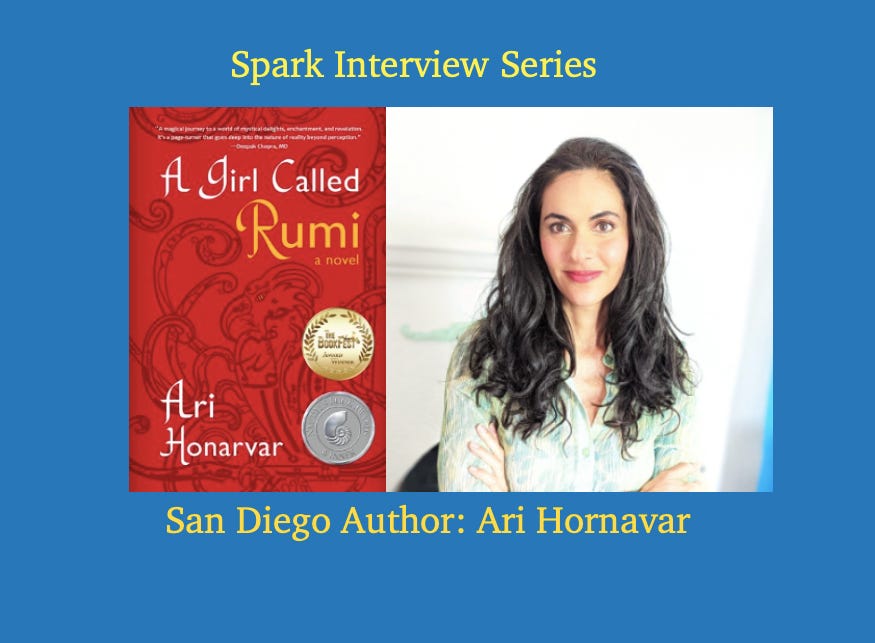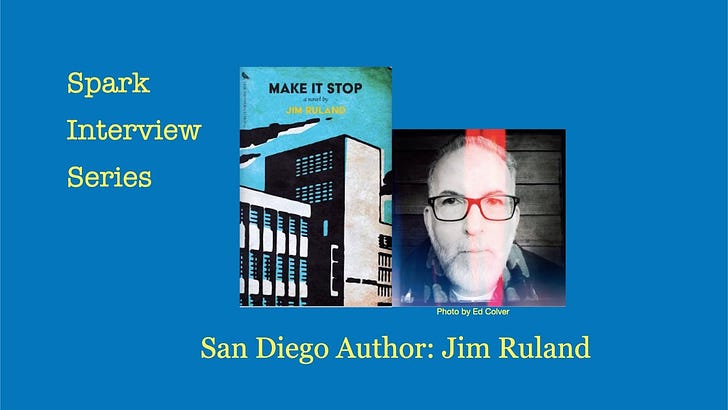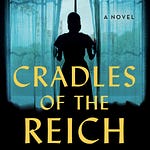Before we begin
If you are a writer, what are the books and authors who have influenced you and your work? If you are a reader, which books and authors have influenced you in ways you may not have predicted? Next week, we’ll be talking about the words and writers who influence us even if we are not aware of it.
Welcome! You’ve reached Spark. Learn more here or just read on. If you received this from a friend, please join us by subscribing. It’s free! All you have to do is press the button below. If you have already subscribed, welcome back! BTW, If this email looks truncated in your inbox, just click through now so you can read it all in one go. Better yet, just click on the sound link and listen!
Hi Everyone,
I’m excited to share my recent interview with Ari Hornarvar, a San Diego-based writer, artist, and activist whose work has appeared in Newsweek, The Washington Post, New York Times, and, now in the pages of her award-winning debut novel, A Girl Called Rumi. Ari is the second writer in our series of interviews spotlighting San Diego writers. You can listen by clicking the sound bar above or by clicking into the video. Here are some highlights from our conversation.
The Leap from Fact to Fiction
Before I’d read Ari Hornarvar’s novel, A Girl Called Rumi, I read some of her op-eds and articles. I was transfixed by a piece she wrote for the Washington Post about adapting concepts from arranged marriage to creating conscious friendships. Her command of issues, deep convictions, and willingness to use her creativity to bridge social issues with art made me wonder how she would approach a long piece of fiction like a novel.
When I opened the book up on my Kindle, I found a story told in five distinct voices whose owners move from back and forth from 2009 to 1981 and whose lives unfold in Shiraz, the fifth largest city in Iran, and in San Diego. In the hands of a less skilled writer or one less willing to experiment, this might have been difficult to bring off in a first novel. Instead it not only works, I can’t imagine this story being told any other way. Her skillful weaving of magical realism with the concrete details of everyday life lifted the story into another dimension. Each chapter, each voice, picked up where the last one left off and once I started, I couldn’t stop reading.
The story focuses primarily on Kimia who is a successful spiritual advisor who has lived in the United States for nearly 25 years when the story opens. An encounter in her mother’s garage triggers her memories as a nine-year-old in war-torn Iran where the country is ruled by religious leaders. She begins reliving her experience, including her friendship with a mystical storyteller who leads her through the mythic Seven Valleys of Love. Grappling with her memories, Kimia agrees to accompany her ill mother back to Iran only to arrive in the midst of the Green Uprising. Against the backdrop of the election protests, Kimia comes to understand the secrets of that night that broke her mother and cemented the hatred of an enemy who was once the mentor of Kimia’s brother, Aram. She must choose between running away again or completing her unfinished journey and facing her own death to save her brother.
Lots of drama. Lots of conflict. What drew me in deepest, though, was Ari Hornarvar’s ability to make me love her characters, even those I should have hated or, at the very least, failed to understand: an abusive mother, an alienated brother and a man who each searched for something essential in the service to the government and religious leaders but ended up in very different places. Similarly, she captures the beauty of growing up in the culture of her Iran, where poetry was as every day as breathing and friends still comforted friends with food and care.
In my recent interview with Ari, the second author in a new Spark series spotlighting San Diego writers and their work, I explored the genesis of A Girl Called Rumi, the parallels between fiction and Ari Hornarvar’s own experience, and how she was able to weave so many elements throughout this novel without losing a single thread. You can listen by clicking on the sound link above or by watching the video below.
Interview Highlights
Her Own Experience Gave Rich Material
In the story, for example, Kimia begins to entertain her schoolmates with imitations of popular television characters during a red alert warning which signaled an imminent attack.
“We were all at school when this happened and everyone was crying and asking for their mothers and I just grabbed the blow horn from my principal and started doing these impressions. Afterwards the parents told my mom that their children had been laughing so hard they didn’t want to go home.”
The terror of living under a theocracy ran deep and was never far away.
“Our neighbor’s daughter was a teenager and she was executed. “Part of the whole terror of living under a theocracy is that whenever you express your dissent against the government, you’re also expressing your dissent against God. We have no idea why she was executed. My father at one point asked the girls’ father and he just shook his head and said I don’t know. They never told us. They just said come and get her body.”
Unlike her protagonist, Ari was alone when she first came to the U.S. at the age of fourteen. She lived with a Houston family for three years before her parents could join her.
“I was delirious with all the newfound freedoms. Now I could dance, I could wear a bikini or shop and no one was going to bat an eye. I could sing from the top of my lungs. I could say death to the president and nothing would happen to me. I was punch drunk with that but at the same time I was completely traumatized because of what I had experienced and seen. When you leave, there is deep grief. You lose your home, your country, your culture.”
“I was carrying the rubble of my shattered childhood within me. I was trying to put the pieces of the puzzle together, to make a home for myself within myself.” - Ari Hornavar on her life after leaving Iran at fourteen.
Saved By A Poem
In the novel, verses of poetry spring forth in everyday conversation, something that Ari remembers well from growing up. Her own mother, like Roya, the mother of Kimia, is a poet. In fact, she credits the poem her mother wrote for the Indian official who was in charge of Ari’s visa application for helping the visa to become reality.
“What I grew up with, someone would ask you a question and you would answer in a verse that everyone knew. I say poetry is as much a part of an Iranian person as their very heartbeat.”
Her Characters Whispered
“I don’t know if this happens with you but my characters whispered in my ears and told me how they wanted to be portrayed. I was surprised how adamant they were when I wanted, for example, to go in another direction. Morteza, for example (the idealog who goes after Kimia and her brother when they return) said, “Look at me. Here’s what’s going on for me. Please tell my whole story, not just that one piece.”
Survival, Madness, and Magical Realism
Some of the novel’s most compelling moments come when we are shown how each character responds to the pressures and fears bearing down on them. Kimia, a rebellious child, retreats into her imagination – or is her discovery of a man she calls the storyteller as real as she is? He tells her of the Seven Valleys of Love and the mythical journey taken by a skyful of birds who gradually dwindle to a few, a metaphor for the stages of understanding. “”It’s an old, old myth told by a mystic. He was one of Rumi’s teachers.” Her brother Arman, on the other hand, seeks the structure and comradeship of a volunteer corp of junior guards who act as morality police even though he remains uncomfortable with the purpose and mission. Their mother, Roya, made fragile by the absence of her husband who is working in the war zone and her own mercurial nature, takes her fear and tension out on her children, particularly Kimia. Their journey apart and then, eventually back to themselves and each other closely parallels the journey towards understanding described by the Storyteller.
Her Own Journey Home
Like Kimia, Ari has returned to Iran since leaving. “It was similar to how Kimia feels when she goes back and she just feels this longing. I wanted to be at home there but it just didn’t feel that way. It was a very strange feeling, not belonging. It’s winking at you wherever you go. Even the cabby says, ‘You have an accent. Where is it from?’ It was a very fraught experience.”
That sense of dislocation can find her here, in the U.S. as well.
“One thing that has happened since I’ve moved is that I’ve created a home within myself inside. That’s where my anchor is.”
What she’s reading
“There is an Iranian writer and filmmaker, Rabeah Ghaffari. I really enjoyed her book. It’s called To Keep The Sun Alive And I really enjoyed a book by a woman I attended a conference with, Emily Francis. She is from Guatemala and we both arrived as unaccompanied minors to the U.S. She teaches English as a second language and the book, If You Only Knew, is composed of letters she has written to her students. You get a tremendous empathy for what these migrants and refugees are going through.”
Advice for writers who have stalled
“Writing is supposed to be really pleasurable for the most part, at least when you are getting your story down on paper. And if your muse is gone and you are frustrated it is because there’s no joy anymore. One thing to do is to bring that joy back through the five senses – the senses are so important to writing anyway. Savoring pleasant moments through the five senses can increase our capacity for challenges. Take a break and go do something you enjoy and come back. Then make a chunk of time with no distraction and try again.”
A little more about Ari Hornarvar
She’s an award-winning writer, speaker, and artist dedicated to building bridges between the arts, social justice, and well-being. Her words have appeared in Parents, Teen Vogue, The Guardian, Washington Post, Newsweek, New York Times, and elsewhere.
A Girl Called Rumi published in 2021, is a BookFest Award Winner, a Nautilus Award Winner, a Locus Award Finalist, a Foreword INDIES Award Finalist. and earned a spot on Kirkus Reviews best books of 2022.
Ari is also the Iranian Musical Ambassador of Peace, dancing with refugees and conducting Resilience through Joy workshops for refugees and volunteers on either side of the U.S.-Mexico border and Europe. She speaks internationally and collaborates with artists of different cultures and is the founder of Drop Poems Not Bombs and Dance for Freedom both aimed at supporting the people of Iran including Iranian protesters.
She has lived in San Diego since 2008 with her family
More about Ari Hornarvar’s Writing, Art, Projects can be found here on her website. You can follow her on social media on Facebook and Instagram. Here is the info about #DancingForFreedom. Although this issue of Spark was published a day after the event mentioned below, you can still search out the dancers and, if you are inspired as I was, it’s never too late to offer your support.

ICYMI
If you missed the first interview in our series spotlighting San Diego Writers, check out this interview with Jennifer Coburn whose novel Cradles of the Reich explores the the lives and choices of women caught up in Lebensborn Society, a Nazi breeding program. One Sparker, Jennifer Redmond, called this her favorite book of 2022.
Spark is Yours: Chime In
Have you just finished a book you loved? Tell us about it. Got a great resource for readers or writers? Share away! How about sharing your book stack with us, that tower of tomes rising next to your bed or your bath or wherever you keep the books you intend to read – someday. And if you stumbled on a Moment of Zen, show us what moved you, made you laugh, or just created a sliver of light in an otherwise murky world.
Thank you and Welcome
Thanks you to everyone who shared Spark with a friend again this week. Welcome to all new subscribers! Thank you so much for being here. If you would like to check out past issues, here’s a quick link to the archives. Be sure to check out our Resources for Readers and Writers too.
That’s it for this week. Let me know how you are and what you’re thinking about. And of course, always let me know what you’re reading. If there’s an idea, book, or question you’d like to see in an upcoming issue of Spark, let us know!
Remember, If you like what you see or it resonates with you, please share Spark with a friend and take a minute to click the heart ❤️ below - it helps more folks to find us!
Ciao for now!
Gratefully,
Betsy
P.S. And now, your moment of Zen…Happy Valentine’s Day
Calling for Your Contribution to “Moment of Zen”
What is YOUR moment of Zen? Send me your photos, a video, a drawing, a song, a poem, or anything with a visual that moved you, thrilled you, calmed you. Or just cracked you up. This feature is wide open for your own personal interpretation.
Come on, go through your photos, your memories or just keep your eyes and ears to the ground and then share. Send your photos/links, etc. to me by replying to this email or simply by sending to: elizabethmarro@substack.com. The main guidelines are probably already obvious: don’t hurt anyone -- don’t send anything that violates the privacy of someone you love or even someone you hate, don’t send anything divisive, or aimed at disparaging others. Our Zen moments are to help us connect, to bond, to learn, to wonder, to share -- to escape the world for a little bit and return refreshed.
Thanks for reading Spark! Subscribe for free to receive new posts and support my work.
And remember,If you like what you see or it resonates with you, please share Spark with a friend and take a minute to click the heart ❤️ below - it helps more folks to find us!
Thanks for reading Spark! Subscribe for free, then share with a friend!











A Young Girl's Journey Back to Herself